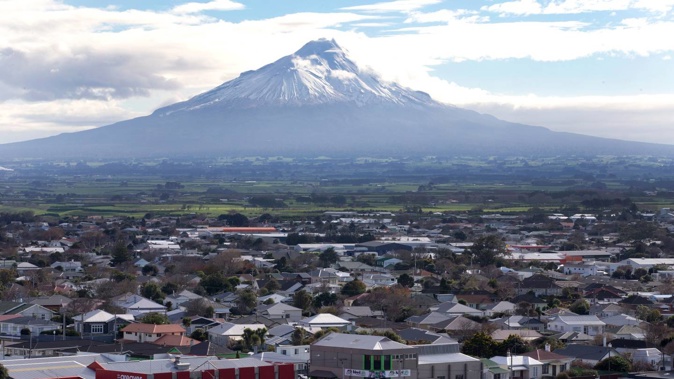
Scientists have built up a completely new understanding of Mt Taranaki's eruption risk - and expect its next blow will prove unlike anything it's produced in the last millennium.
The imposing, 2500m-high stratovolcano is considered to be in a "quiet period" - its last eruption occurred in 1790 - making it among its longest on record.
Based on an analysis of nearly 230 eruptions over the last 30,000 years, researchers have put the probability of a new eruption at between one and 1.3 per cent each year.
While the probability is low, the risk is significant: more than 85,000 people live within 30km of the mountain, with 40,000 in high-priority evacuation areas.
A recent estimate of the net losses in economic activity from a brief Taranaki eruption was crudely estimated at between $1.7b and $4b – or between $13 billion and $26b over a decade of volcanism.
The volcano's fiery history has been laid out in a sprawling new review, bringing together 25 years of research, and published in the New Zealand Journal of Geology and Geophysics.
"What has emerged from this analysis is the realisation of how Mt Taranaki represents the most recent of a long lineage of volcanoes that extends from west of Auckland, all the way down the western offshore margin of the North Island," University of Auckland volcanologist Professor Shane Cronin said.
Those Taranaki volcanoes we could see today - Taranaki, Pouakai, Kaitake and Paritutu - represented just the last 1.7 million of about 40 million years of activity in the North Island's western volcanic province.
While Taranaki eruptions had been variable over time, in scale and frequency, scientists had still been able to observe a regular pattern of "busy times" lasting 1000 to 1500 years.
Over the past 3000 years, there have been about seven periods where tens to hundreds of individual eruption events took place, and only perhaps a few that could be considered one-offs.
In one period, about 2000 years ago, there were at least 11 extremely large ash-producing events that spewed ash across vast areas of the North Island.
The most recent eruption period - called the "Maero eruptive period" - came between 1000AD and 1790.
In these unsettled periods, Cronin said eruptions typically happened every 20 to 30 years, compared with once a century in the slow times.
"We are in a slow period at the moment, so we expect that once it begins erupting again, it will resume the 'busy' frequency."
/cloudfront-ap-southeast-2.images.arcpublishing.com/nzme/JCWNOXO6OYGCH33UZMECARYDOE.jpg?width=810&height=538&mode=max) The chances of eruption at Mt Taranaki are put at between one and 1.3 per cent each year. Photo / Clive Wilkinson
The chances of eruption at Mt Taranaki are put at between one and 1.3 per cent each year. Photo / Clive Wilkinson
Taranaki's next eruption
Scientists have been able to sketch out several specific scenarios that have repeatedly played out in the past.
Past eruptions have come from both Taranaki's summit and Panitahi/Fanthams Peak - and it was clear both vents could independently blow in the future.
"Most eruptions are long and complex events, and many produce both ash fall and pyroclastic flow deposits," he said.
"The ash from Mt Taranaki is very widely dispersed, easily reaching Auckland and the central North Island."
Along with that, the region's high rainfall meant any eruption could trigger widespread floods and lahars.
"We know also that Mt Taranaki has collapsed many times in its past, and rebuilt," he said.
"There were at least 15 older versions of the volcano. The present form of Mt Taranaki has been shaped only over the last 10,000 years."
What further set it apart from other New Zealand volcanoes was its tendency to produce lava domes.
"A good active analogy at the moment is Sinabung volcano in Indonesia – which has been erupting for several years and produces lava domes – viscous blobs of lava that rise out of the summit crater."
With these came the most deadly of all volcanic risks - hot and fast-moving pyroclastic flows that tore down the mountain and spread outward.
"At Mt Taranaki, the smaller eruptions produce pyroclastic flows that reach out from the national park boundary and focused mainly in the main river channels," Cronin said.
"We have also recently found that some of these, during the largest eruptions of the volcano may reach very long distances – as far as 25km from the volcano, reaching the coast in cases."
With these recent insights, Taranaki Civil Defence planners were now working on new hazard models and zones.
Before the next blow, earthquakes around the volcano - beneath which several fault zones were buried - might give an early warning.
"By comparing results from tectonic and volcanic studies we are able to show that the largest eruptions are associated with major earthquakes along the north-south trending faults," he said.
"Currently, Mt Taranaki is well monitored by a series of seismic stations – these will tell us how earthquake patterns are changing and help to identify new magma moving to the surface."
/cloudfront-ap-southeast-2.images.arcpublishing.com/nzme/5QJ4TOJLERNOZU7PJ7FBAMTYOE.jpg?width=830&height=545&mode=max) A recent estimate of the net losses in economic activity from a brief Taranaki eruption was crudely estimated at between $1.7b and $4b. Photo / Christine Cornege
A recent estimate of the net losses in economic activity from a brief Taranaki eruption was crudely estimated at between $1.7b and $4b. Photo / Christine Cornege
Living with disaster?
Cronin said there weren't any "catastrophic" scenarios, so we could shut out any images of devastating super-eruptions.
Rather, he said Taranaki would likely generate long-term, "really annoying and disruptive" effects right across the country.
"Its location with respect to the main wind directions means that ash will be dispersed across most of the North Island and its impacts will be felt from Auckland to Wellington," he said.
"However, with good planning it shouldn't be a volcano that generates major loss of life."
The kind of volcanism seen in the past wouldn't require the evacuation of the whole region, and if the hazards could be understood now, we could manage them in the future.
"Most eruptions we expect are of a scale and type that we can adapt to."
New Plymouth, particularly, might be hit by ash affecting water supplies, transport and general health - but Cronin said there were plenty of places around the world that had learned to live with disruption.
"For farmers and business around the region, impacts will also be highly localised and close attention during eruption episodes will help to understand where and when different areas may be affected," he said.
"Once volcanism begins, the region will have to transition into a 'new normal' of living alongside the volcanism.
"However, what we see from the geological record and from similar volcanoes around the world show us that this is possible.
"It is possible to survive - and thrive even - with an erupting volcano."
Cronin is now leading a major five-year study focused on Taranaki, supported with a $13.7m grant through the Government's Endeavour Fund.
Take your Radio, Podcasts and Music with you









